The Definitive Guide to Storing Food without Plastic
Taking reusable bags to the store is a great way to reduce unnecessary plastic. Bringing reusable produce bags and selecting products without packaging is another way to reduce waste. Choosing to shop at bulk stores is a fantastic option, if we have the choice.
But what about when we get all of our food shopping home? What then? Is it possible to store food without plastic?
What about leftovers, and freezing food? How about packing lunches?
What are the plastic-free options?
Of course, plastic-free is possible. There are plenty of options to avoid using plastic containers, gladwrap/clingwrap and zip-lock bags. From choosing plastic-free containers to freezing in glass (yes, it’s possible), here’s the lowdown on how we avoid using plastic in our home when storing food.
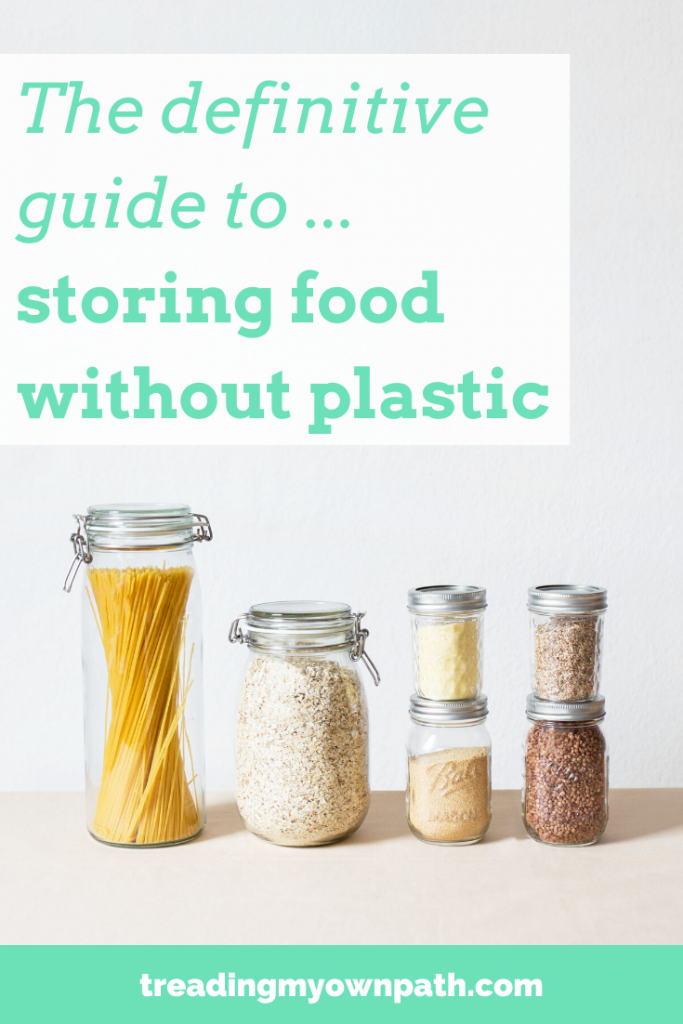
Food Storage without Plastic – the Pantry
I buy all of our dry goods from bulk stores, and I store in the pantry in glass jars. Sometimes I take the jars to the bulk stores and weigh them before filling them, but more often I take reusable produce bags and decant when I get home.
Glass jars are heavy, and I find taking reusable produce bags is more practical for me.
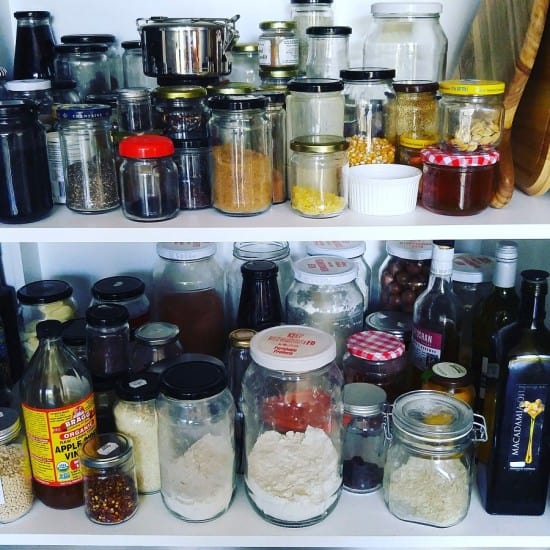
Whilst I love the idea of a pantry full of matching glass jars, the reality is, there are plenty of glass jars in the world begging to be re-used. It makes no sense to me to buy new when I can re-use. I’ve reused old jars that I own, and friends and family have given me their spares. I sourced some big glass jars from a local cafe.
I generally find that a good soak will get the old labels off. If they are particularly stubborn, I use eucalyptus oil and give them a scrub, and that usually works. Removing the label means I can see what’s inside, and there’s no confusion as to the contents.
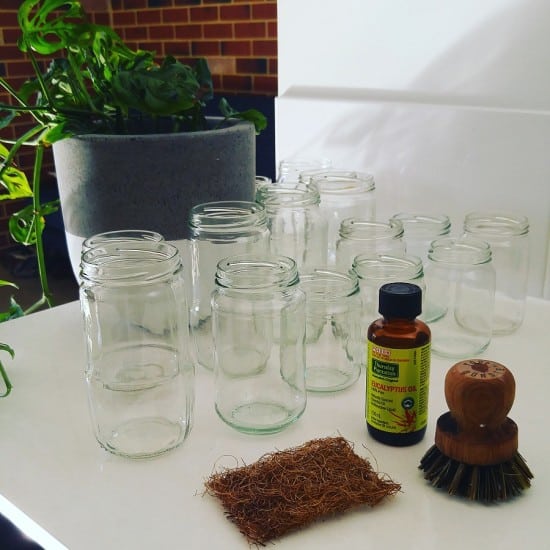
I have needed to buy a few new jar lids – kitchen shops sell these, or you can find them online.
It’s not always clear how long dry goods have been stored at the bulk shops, and the last thing we want is weevils or pantry moths, or other pests. If I think something has been at the store a while, or if it’s been in my own pantry a little longer than planned, I pop the jar into the freezer for 24 hours. This kills any eggs. After 24 hours I remove the jar from the freezer and place back in the pantry.
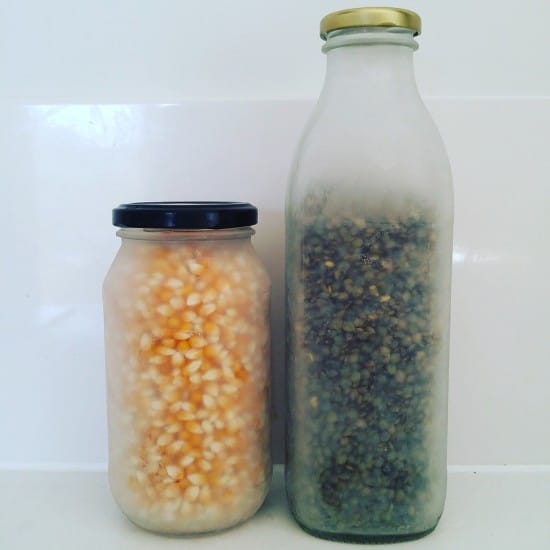
I have a terrible habit of not labeling my jars. I have a good memory and generally remember what I’ve bought, and if I forget I can usually figure it out by the smell. My husband has no idea what I’ve bought and has a terrible sense of smell, so whilst it might work for me, it doesn’t work for him! I’m planning to get a greaseproof pencil/chinograph so I can label the jars without needing to buy sticky labels or mark them permanently. If I was more crafty, I could paint blackboard paint on them, or even mark the lids.
Food storage without plastic – on the counter
I keep a fruit bowl on the counter which in addition to fruit, contains onions. I also keep fresh tomatoes here as I find they taste better than when stored in the fridge, and avocados whilst they ripen.
I often keep cut leaves such as beetroot leaves or silverbeet in glass jars on the counter rather than in the fridge as I find they keep better. Parsley and some other herbs also keep better this way. If the water is changed regularly, parsley will last on the counter for up to two weeks.
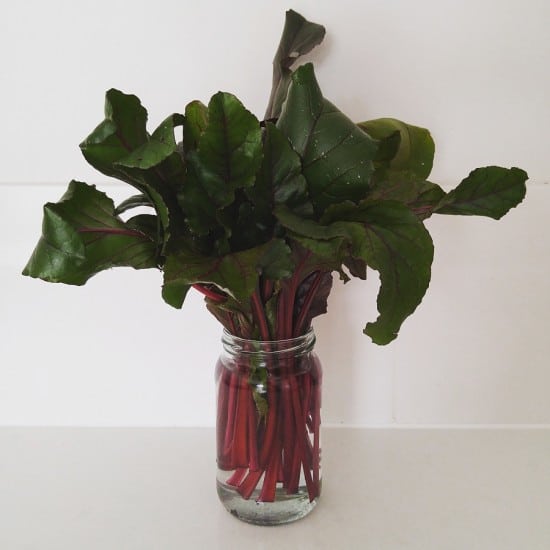
I store my bread in a cloth bag inside a wooden bread bin. The cloth bag helps absorb any moisture that might cause the bread to go moldy. Over time it begins to harden, and when I notice it’s becoming hard to cut I pre-cut the rest of the loaf. If there is more than I can eat in the next day or so, I pop it in the freezer.
For things like crackers, baked goods and other dry food, I use tins. I have some that I purchased in my pre- zero waste days, and some that I’ve been given (they often seem to appear around Christmas time as “presentation” boxes for biscuits and confectionery). I’ve been able to choose ones that are a good size for my needs, and that I can store easily.
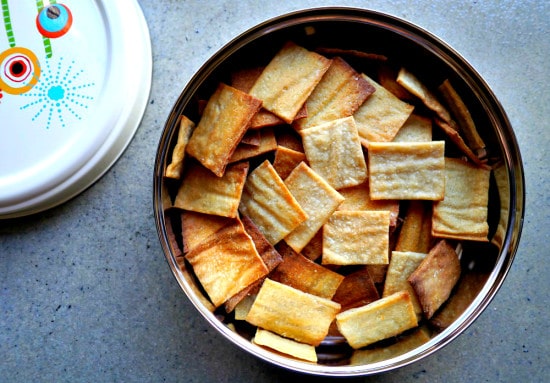
Food storage without plastic – the fridge
I store most of my fruit and vegetable items in the crisper. Some veggies, such as carrots, courgettes and cucumbers have a tendency to go floppy, so I store these in a rectangular glass Pyrex container with a lid. I also find delicate fresh herbs like coriander and basil store better in a container with a lid, as do salad leaves.
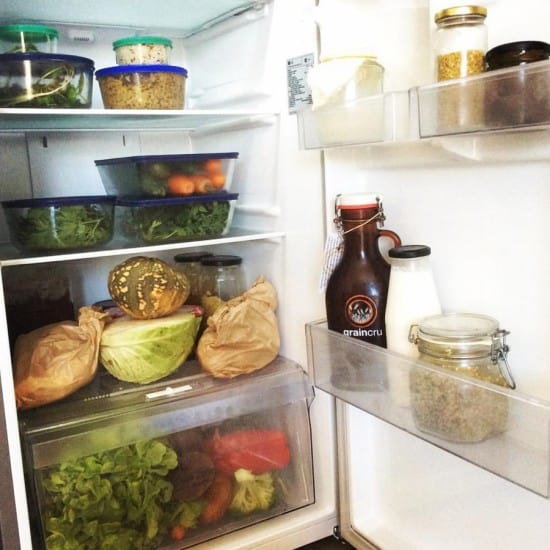
I’ve also tried storing them in glasses or bowls of water in the fridge and this works well, but I don’t own enough glassware for this to be practical.
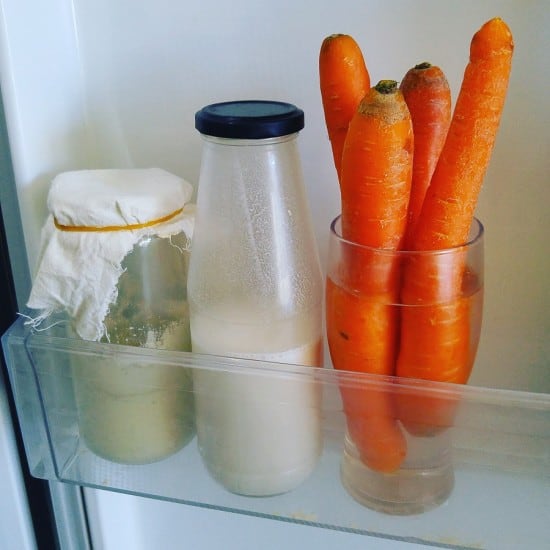
Another alternative to using glass containers is to use a damp tea towel to wrap your veggies. This works particularly well for larger items like bunches of celery or leafy greens that don’t fit in containers. Beeswax wraps are also useful if you’re not vegan – they are cloth squares that have beeswax melted onto them to create a waterproof wrap. They are very easy to make yourself (you can find a DIY beeswax wrap tutorial here) and making your own means you can choose sizes that work for your needs.
For storing leftovers, there are a number of solutions. Personally I was never a fan of gladwrap/clingfilm. Some is ridiculously sticky and will stick to everything except the bowl in question (this type of clingwrap usually contains phthalates – not what we want to be wrapping food in). The phthalate-free type never seems to want to stick to anything at all. I find it far simpler simply to put a plate on top of the bowl in question.
I also have some silicone covers for bowls that were a gift that have been very useful. Beeswax wraps can be used for this, too. Glass jars are a great option for decanting small amounts of leftovers (and I have plenty of glass jars to hand), and Pyrex storage or stainless steel work if you want to decant into something bigger. Sometimes I even keep the food in the saucepan, pop the lid on and pop that in the fridge.
For some items, such as half a lemon or half an avocado, I find that placing it face down on a plate is enough. If I’ve roasted veggies or baked a sweet potato, I find it keeps well in the fridge uncovered for a few days. So long as it’s not got a strong smell, it works fine.
Food storage without plastic – the freezer (yes, you can freeze food in glass)
I store most of my food in the freezer in glass jars. I’ve been doing it for 10 years. Jars are a great size for one or two portions, and they fill the space well. I’ve only ever had one breakage. Freezing in glass is perfectly safe, but there are some rules to follow.

Firstly, choose good quality jars, with thick glass. Repurposed jars are fine. I tend to choose ones that have previously had jam or tomato sauce in them, as I know they will withstand changes in temperature. Buying poor quality jars from reject shops will likely lead to breakages.
Wider jars work better, and avoid any that taper inwards at the top (tapering outwards is fine). When filling, never fill all the way to the top – make sure the food is sitting at the widest point of the jar. Don’t screw the lid on until the contents have completely frozen. The food will expand when frozen – the higher the water content the more it will expand – so leave room for this to happen. Once it’s frozen you can screw on the lid.
Never put hot jars in the freezer, and try to chill them before you freeze them. This is important if what you’re freezing has a high water content, like stock. I find for foods like chickpeas, which don’t have a high water content, freezing from room temperature works fine.
If you’re worried about freezing in jars, you can also use freezer-safe Pyrex, or stainless steel containers, which won’t break.
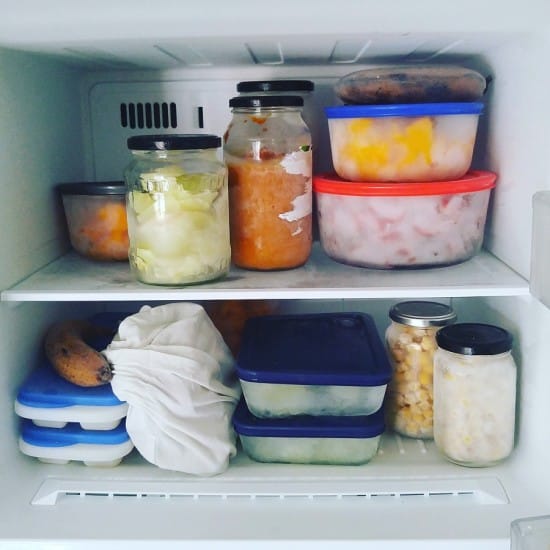
I use an ice cube tray for freezing liquids and also fresh herbs. I find that the cubes make good portion sizes. I store the cubes in jars once they are frozen. To freeze herbs I add a little oil to the ice cube tray -they seem to freeze better. I have just upgraded to a stainless steel one, and you can also find aluminium ones second-hand if you’d like to avoid plastic.
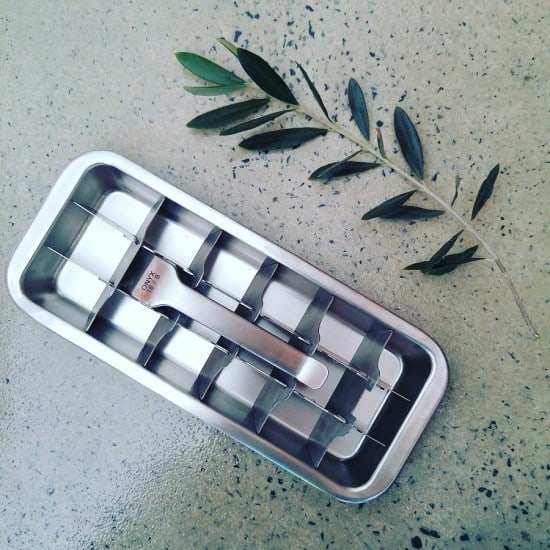
To avoid freezing a big mass of fruit, I lay out on on a tray (I line a baking tray with a tea towel) and pop in the freezer. Oonce frozen, I put in a container. This allows me to use a handful at a time, rather than needing to defrost the whole thing.
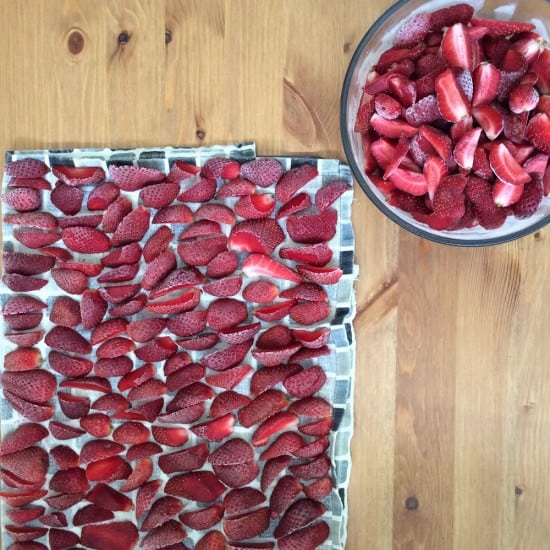
I don’t freeze everything in glass. I freeze bread wrapped in a cloth bag, and I leave bananas in their skins.
Food storage – out and about
Both my husband and I have stainless steel lunchboxes, which we use for food on the go. I always take my glass KeepCup with me as I find it great as an impromptu storage container. Being glass, it’s easy to clean. I have a set of reusable, washable wraps for sandwiches, baked goods and snacks which are handy as they fold up. If we’re taking food to friends’ houses, we either use tins or we have a stainless steel tiffin.

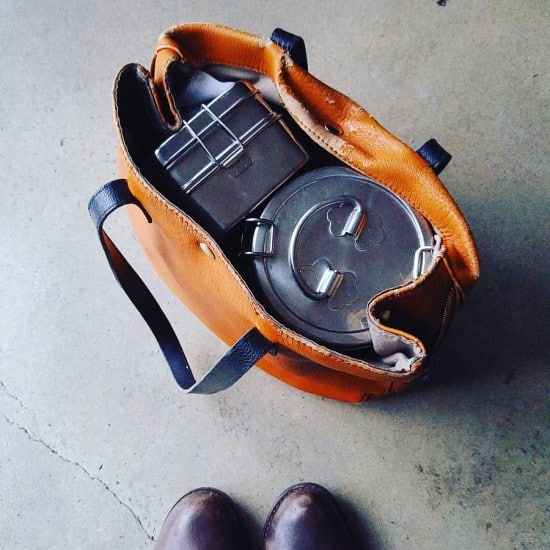
Food storage – choosing containers
When I first started out with living plastic-free, I had a lot of plastic reusable containers. I didn’t want to waste them, so I continued to use them whilst I transitioned to other things. Because I was concerned with the health implications of using plastic for food storage, I used them only for dried food, before giving them away or using them for non-food items.

Whatever you decide to use, know that there’s no need to immediately rush out and buy new stuff. Glass jars are an obvious one to start with, and they are free. It’s possible to find good quality glass, tins and even Pyrex at the charity shops.
I chose to use Pyrex with the plastic lids, because I couldn’t find any without plastic, and they were affordable for me. Stainless steel containers come completely plastic-free, but they are an investment. They are expensive but should last forever, so it is important to know exactly what you want before you make the purchase. Slowly I’ve built up a small collection of stainless steel, and the pieces I have I use often and I love.
When choosing containers, think about how you’ll use them. If you’re looking for a lunchbox, think about the kinds of things you eat for lunch. What size and shape will be most useful? Planet Box make great compartmentalised lunch boxes for kids. Cloth wraps and reusable sandwich bags might be a better alternative. It’s possible to buy refillable food packs. Think about your needs and choose products that work for you.
It is possible to store food at home without using plastic, and you can make it as simple or as complicated (or as cheap or expensive) as you like. The most important thing is to make conscious choices. Look at your options, and decide what is practical and within your budget. There’s no need to buy new things straightaway. Take your time. Choose well.
Now I’d love to hear from you! Tell me, how do you store your food without using plastic? What are your favourite tips? Is there anything you tried that didn’t work? What purchases have you made that have been great investments? Any that turned out to be duds? Do you have any tips to add? Or any “not-to-do”s to share? Is there anything that you are still searching for a solution for? Any questions? Tell me your thoughts in the comments below!
[leadpages_leadbox leadbox_id=123a865e9839c5] [/leadpages_leadbox]




